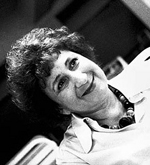
-
 Margot Benacerraf
Margot Benacerraf
(Venezuela, 1926)
Nacida en Caracas en 1926, Margot Benacerraf se graduó en 1947 en la primera promoción de Filosofía y Letras de la Universidad Central de Venezuela. Durante varios años colaboró en varias revistas venezolanas y extranjeras, en las cuales publicó artículos y ensayos. Posteriormente, escribió la obra de teatro Creciente que obtuvo el primer premio, instituido por universidades nacionales y norteamericanas, que consistía en una beca para estudiar teatro en la Universidad de Columbia. Entre 1950 y 1952, estudió Dirección Cinematográfica en IDHEC (Instituto de Altos Estudios Cinematográficos de París).
En 1951 filmó su primera película sobre la vida del pintor venezolano Reverón, un documental de media hora de duración que ha sido ampliamente reconocido a nivel nacional e internacional por sus grandes valores y aportes innovadores. Una anécdota de Margot Benacerraf relata que al terminar de filmar Reverón, el peculiar pintor la hizo vestir con una sotana hecha por él mismo y la puso a perdonar a cada una de sus muñecas (obras del artista) varias veces.
En 1959, su largometraje Araya es presentado en el Festival de Cannes y ganó el Premio de la Crítica Internacional (FIPRESCI), compartido con Hiroshima, mon amour de Alain Resnais, y el Premio de la Comisión Técnica Superior del Cine Francés. A partir de ese momento, Araya es solicitada para participar como invitada especial en varios festivales internacionales. Araya es una película que muchos piensan que es un documental pero en realidad es una historia dramatizada en la que Benacerraf no utilizó actores sino gente común del pueblo. Siempre guardo en mi memoria una de las escenas más poéticas y es aquella cuando la gente para rendirle tributos a sus muertos, a falta de flores frescas por lo yermo del terreno, le llevan caracoles del cercano y fecundo mar.
Por su novedad y su importancia, Araya fue escogida como una de las cinco mejores películas en la historia del cine latinoamericano, dentro de la Retrospectiva de Latin American Visions (A Half Century of Latinamerican Cinema 1930-1988), organizada por el Neighborhood Film/Video Project de Philadelphia, en 1990.
Margot Benacerraf fundó la Cinemateca Nacional en mayo de 1966 y la dirigió durante los tres años subsiguientes. Aun hoy en día es miembro principal del Consejo Directivo, al igual que del Ateneo de Caracas. Además, Preside el Festival de Cortometrajes de Caracas que organiza Fundavisual Latina (Fundación que fundó y también preside) cada dos años.
Ha recibido numerosos reconocimientos, entre ellos se destaca el Premio Nacional de Cine (1995), la Orden Andrés Bello (en dos ocasiones), la Orden Simón Bolívar, Orden del Gobierno Italiano y la Orden Bernardo O’Higgins del Gobierno de Chile, entre otros.Falleció el 29 de mayo en Venezuela, a la edad de 97 años.El ministro de Cultura de su país, Ernesto Villegas, lamentó el fallecimiento de la cineasta a quien consideró como “insigne cineasta” venezolana, que elevó la cinematografía nacional al máximo nivel de reconocimiento internacional y fundó la Cinemateca Nacional en 1966.
Margot Benacerraf (1926-) born in Caracas, Venaezuela. She graduated in 1947 as part of the first promotion of the studies of art at the Venezuela Central University. For some years, she contributed to some Venezuelan and foreign magazines in which she published articles and essays. Then he wrote the theater play Creciente that was an award-winner of the first prize of an award established by Venezuelan and American Universities that consisted of a scholarship to study theater at the Columbia University. From 1950 to 1952, she studied film direction in the IDHEC (High Studies Film Institute of Paris).
In 1951, she made his first film work about the life of the Venezuelan painter Raverón, a 30 minutes documentary that has been widely national and internationally acclaimed for his great values and innovative contribution to filmmaking. An anecdote of Benacerrat tells that when she finished the film, the peculiar painter made her to dress with a soutane designed by himself and made her to forgive repeatedly each one of his dolls (works of the own artist).
In 1959, his feature film Araya was shown at the Cannes Film Festival and won FIPRESCI award, shared with the French film Hiroshima, mon amour by Alain Resnais, and the prize at the High Technical Commission of the French Film. From this moment on, Araya is requested to be screened as special film at international film Festivals. Many people think that Araya is a documentary, but it is really a dramatized story in which Benacerraf did not use actors but common people. One of the most memorable and poetic scene is the one in which the people to pay tribute to their dead take snails from the near by and prolific sea, because of the absece of fresh flower in a barren ground
Because of its novelty and importance, Araya was selected as one of the best five films in Latin American cinema History, at the retrospective Latin American Visions (A Half Century of Latin-American Cinema 1930 -1988) that was organized by the Neighborhood Film / Video project of Philadelphia in 1990.
Margot Benacerraf founded the National archive in May 1968 and directed it for three years. She is still one of the main members of the directive council of the National Archive and the cultural center Ateneo de Caracas. She is also president of the Caracas Short Film Festival organized by Fundavisual Latina (institutions that she founded and presides over) every two years.
She has received a great numbers of recognitions; among them are relevant The National Film Prize (1995), the Andres Bello Order (twice), the Simón Bolivar order, The Italian government order, and Chilean Government order Bernardo O´Higgins.

Referencias en el Portal:
Reverón, 1951, Dirección
Araya, 1958, Dirección

